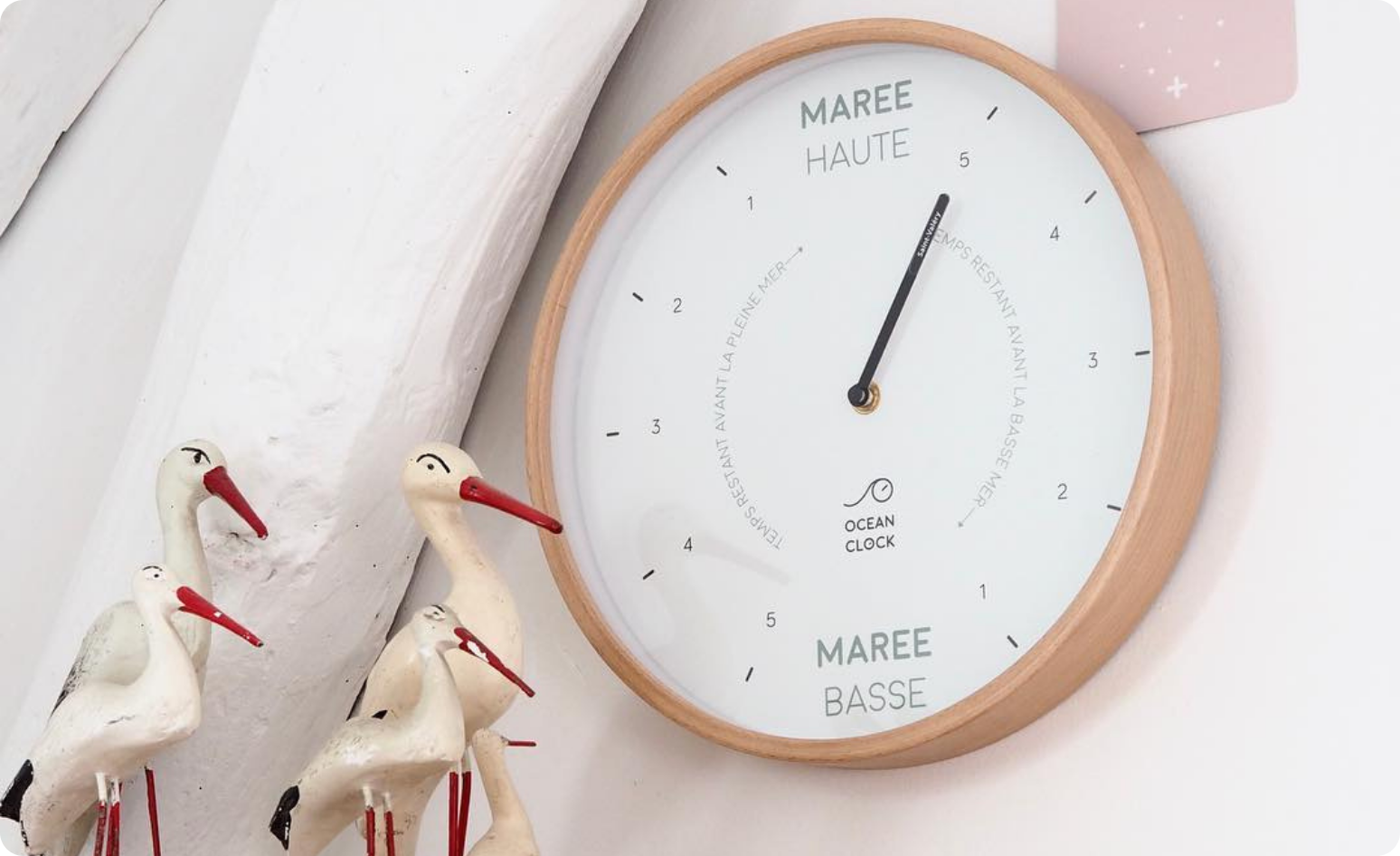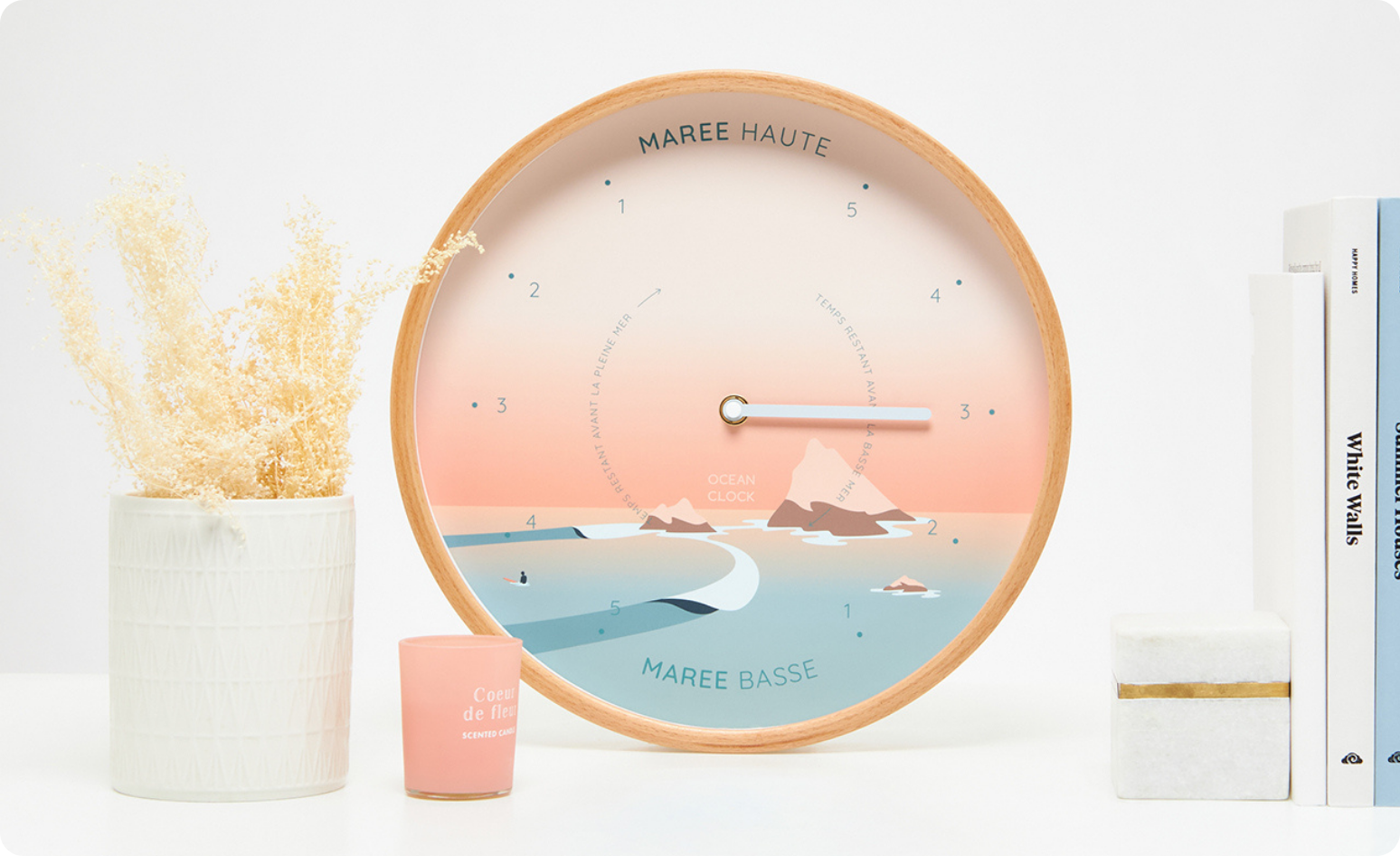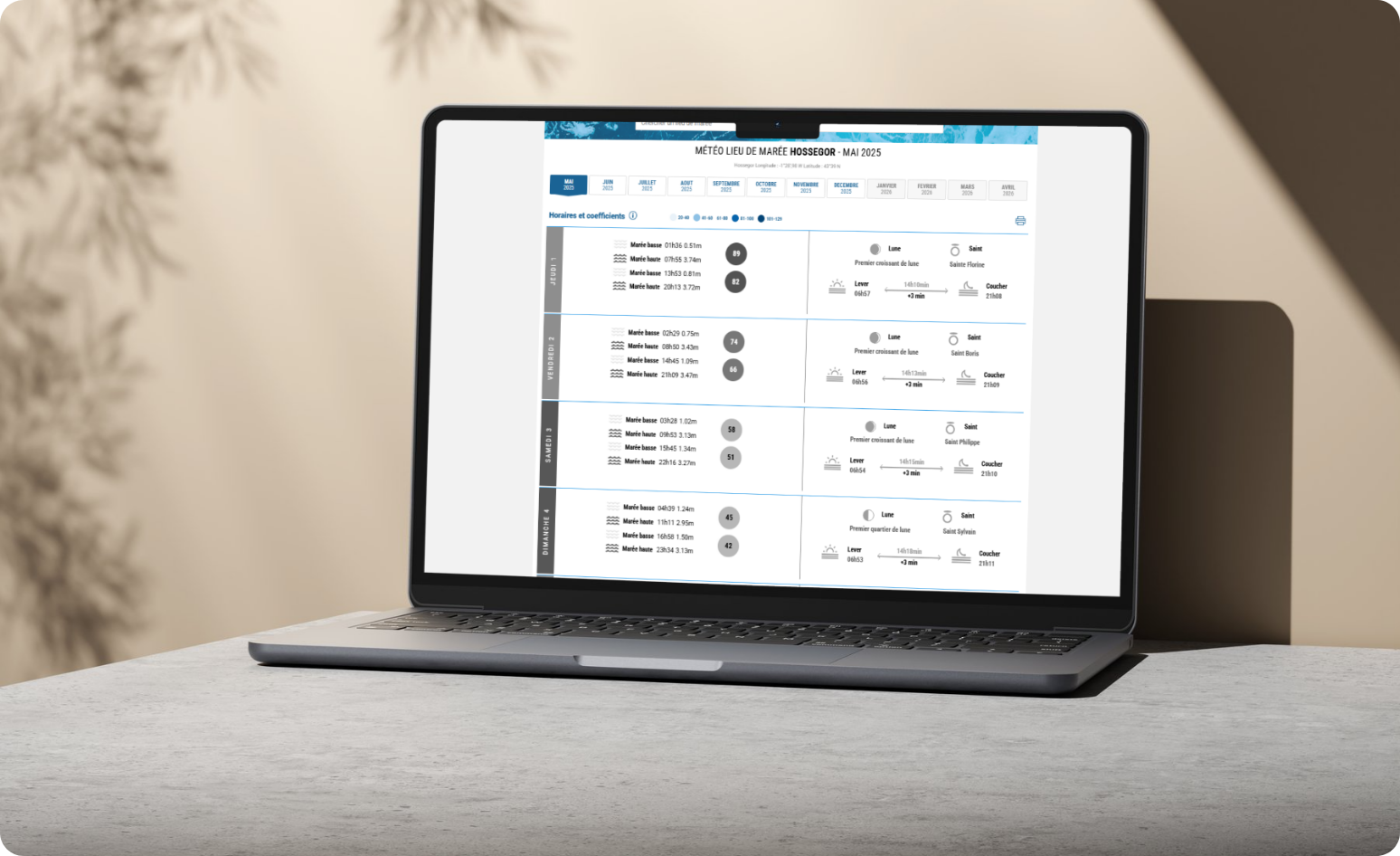Understand in a Flash!
How to Set a Tide Clock
Properly setting your tide clock from the start is a crucial step to ensure it works efficiently and displays relevant information. Unlike a regular clock, which shows the universal time, a tide clock must be precisely adjusted according to the local tides.
Simple & Quick Setting Module
Using this module is simple and accessible to everyone. Just enter the name of your coastal town into the interface, and the clock hand will be displayed virtually on the dial. This step is crucial, as it visually guides you on how to position the hand so that the clock perfectly matches the local tides!
1. Desired Tide Location
The clock shown here will now guide you on where to place your hand!
2. Set your tide clock
Position the hand as shown above using the dial on the back of the clock, then insert the battery (Duracell Plus or fully yellow Varta Longlife recommended).
Note:
This adjustment may cause a slight discrepancy from the current tide state, but it will automatically correct itself and remain minimal throughout the year.
The Importance of Setting
The initial setting allows the hand to synchronize with the tidal cycle of the chosen location. If this setting is done incorrectly, the clock will lose accuracy and will not accurately reflect the state of the tides.
The proper functioning of your clock depends on precise adjustment. This setting is especially important because the tide is not a fixed phenomenon and varies daily. Thanks to this initial calibration, your clock will be able to reliably indicate the tides for the months to come.
Thus, a good startup ensures that you can fully benefit from your tide clock, whether to plan a sea outing or to enjoy tide-related activities along the coast.

Optimal Setting
To achieve an optimal setting for your Ocean Clock tide clock, the following module takes into account various essential factors for accurate tide reading. Unlike traditional manual adjustments, this module incorporates elements such as lunar phases, tide coefficients, and other data related to local conditions. These parameters greatly influence tidal movements, and the module ensures that your clock faithfully reflects these variations.
The technical details of the module
The module automatically calculates the information based on the geographical and astronomical specifics of your location, ensuring enhanced accuracy. One of the key strengths of this technology is that it relies on complex algorithms incorporating lunar cycles. Indeed, tides are primarily influenced by the moon’s gravitational pull, and significant variations can occur depending on the lunar phases (full moon, new moon, etc.). That’s why our module automatically adjusts the hand according to these fluctuations.
Besides lunar factors, the module also takes the tide coefficient into account. This measures the tide's amplitude, indicating whether the tides will be higher or lower than usual. Based on local data, the module adapts the indicator to anticipate these variations and avoid any mismatch with reality. This allows you to benefit from a reliable reading of the tides, regardless of the time of year.
When the hand appears on the display, you should adjust your actual clock in the same way, positioning the hand exactly as shown.

This process is both intuitive and precise, and once completed, your clock will be ready to operate autonomously. You will no longer need to adjust it manually, except in cases of relocation or battery replacement.
By using this module developed specifically for Ocean Clock, you ensure not only an accurate setting but also a reliable tide tracking that reflects the real conditions of your location. It is the best way to fully enjoy your tide clock, whether you live by the sea or simply want to follow the tides from home.
In summary, this innovative module is the result of advanced development designed to guarantee our users the best possible experience with their Ocean Clock tide clock. It takes only a few minutes to perform an accurate setup, allowing you to enjoy a tool that is both practical and decorative, perfectly tailored to your needs.
Traditional Adjustment
Manual setting of your tide clock: a simple method for your water activities
Using this manual setting method is easy and only requires a few basic pieces of information. Although less precise than using the integrated electronic module, this manual adjustment is perfectly suitable for recreational use, especially for activities such as kitesurfing, fishing, or seaside walks.

First, you need to have the tide calendar for your reference port, which indicates the water height, the coefficient, and the times of high and low tides. If you don’t have a traditional tide calendar, you can also find them for free online, for example on the Météo Marine website.
Choose a day with a high tide coefficient, starting from 85. But what is the tide coefficient? It is an indicator calculated to show the amplitude of the tide. It can vary between 20 and 120. We recommend choosing a day when the coefficient is rather high to minimize any discrepancies between the clock and the actual tide status.
Preferably pick a new moon day
For optimal accuracy, we advise selecting a new moon day to perform the setting. This way, the clock’s indications will align as closely as possible with the tide calendar throughout the year. To find new moon dates, please consult the tide calendar.
Set the clock on the chosen day
Finally, note the time of the high tide or “pleine mer.” You just need to place the hand on “high tide” using the dial on the back of the clock and insert the battery at the right time.
This method can be a bit restrictive since you need to be available at a precise date and time. The day to set your clock has arrived! All that’s left is to read the high or low tide time on your clock before heading to the ocean.
Adjustments
Under no circumstances should you regularly adjust the tide clock, as this can impair its proper functioning! If you notice slight discrepancies, it is unnecessary to reset the tide clock because these deviations will be naturally compensated by the upcoming tidal cycles.
However, if you have chosen the traditional adjustment method, it is recommended to perform a new adjustment after the equinox periods. These periods correspond to the seasonal changes from winter to spring (late March) and from summer to autumn (late September). You should wait for the next new moon and then follow the previous instructions or use our adjustment module.
But why adjust again? It is simply because the strongest tides occur during the equinox periods due to the combined gravitational pull of the Moon and the Sun on the Earth, as well as the Sun’s position relative to the Equator.
To learn more, check out our article explaining the tidal phenome

CHOOSING THE BATTERY
Choosing the right battery is a crucial factor to ensure the longevity and proper functioning of a clock. Not all batteries are suitable for clocks, and selecting the wrong one can cause irreversible damage to the mechanism.
It is essential to use AA / LR6 batteries with a voltage of 1.5V. At Ocean Clock, we recommend Duracell Plus or Varta Longlife batteries (fully yellow).
⚠️ Batteries labeled "Super Power," "Max," or "Optimum" are often too powerful for the delicate movements of clocks. These batteries deliver a current higher than what the mechanism can handle, causing premature wear of parts or even irreversible breakdowns.

Another important point not to overlook is to replace the batteries as soon as they show signs of weakness. If a battery no longer has enough power, the clock may not function properly, causing delays or sudden stops. Inserting a new battery ensures a smooth and continuous movement of the hand, without risking the clock’s accuracy.
It is also not recommended to use rechargeable batteries in a clock. These batteries usually deliver only 1.2V to 1.3V, which is insufficient to properly power a mechanism that requires a constant power supply. Below 1.5V, the clock may lose efficiency and this can lead to irregularities in the movement.
CHECK OUT OUR FAQ
Having an issue with your product?
If you encounter a problem with one of our products, don’t worry! We invite you to consult our FAQ, where you will find answers and solutions to the most common issues. This will help you resolve the situation quickly and easily. If needed, our team is of course available to assist you.












